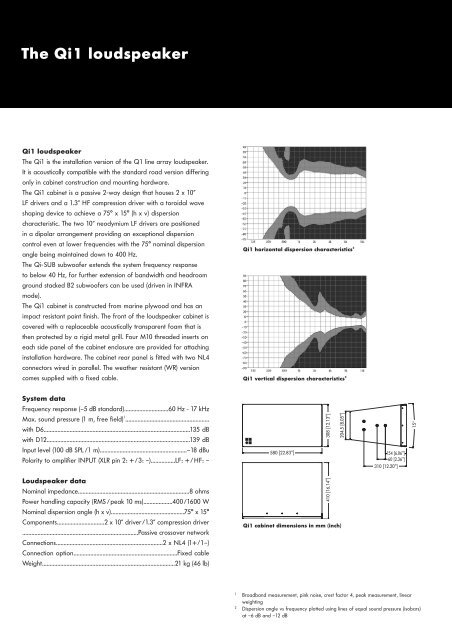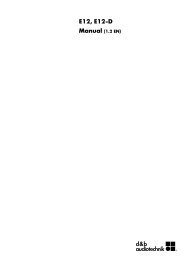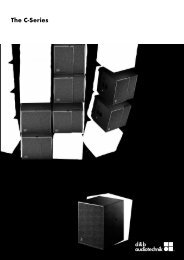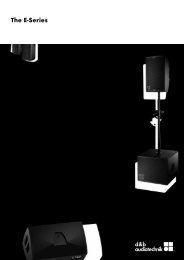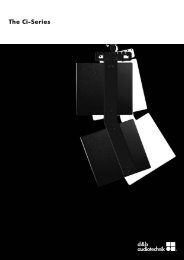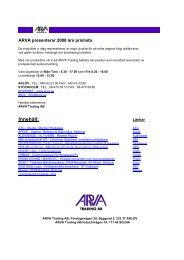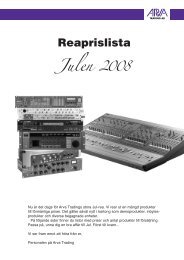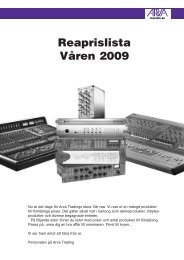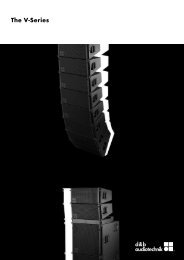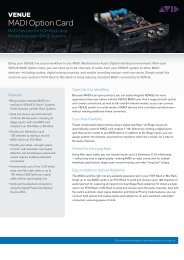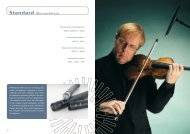The Qi-Series
The Qi-Series
The Qi-Series
You also want an ePaper? Increase the reach of your titles
YUMPU automatically turns print PDFs into web optimized ePapers that Google loves.
<strong>The</strong> <strong>Qi</strong>1 loudspeaker<br />
<strong>Qi</strong>1 loudspeaker<br />
<strong>The</strong> <strong>Qi</strong>1 is the installation version of the Q1 line array loudspeaker.<br />
It is acoustically compatible with the standard road version differing<br />
only in cabinet construction and mounting hardware.<br />
<strong>The</strong> <strong>Qi</strong>1 cabinet is a passive 2-way design that houses 2 x 10”<br />
LF drivers and a 1.3” HF compression driver with a toroidal wave<br />
shaping device to achieve a 75° x 15° (h x v) dispersion<br />
characteristic. <strong>The</strong> two 10” neodymium LF drivers are positioned<br />
in a dipolar arrangement providing an exceptional dispersion<br />
control even at lower frequencies with the 75° nominal dispersion<br />
angle being maintained down to 400 Hz.<br />
<strong>The</strong> <strong>Qi</strong>-SUB subwoofer extends the system frequency response<br />
to below 40 Hz, for further extension of bandwidth and headroom<br />
ground stacked B2 subwoofers can be used (driven in INFRA<br />
mode).<br />
<strong>The</strong> <strong>Qi</strong>1 cabinet is constructed from marine plywood and has an<br />
impact resistant paint finish. <strong>The</strong> front of the loudspeaker cabinet is<br />
covered with a replaceable acoustically transparent foam that is<br />
then protected by a rigid metal grill. Four M10 threaded inserts on<br />
each side panel of the cabinet enclosure are provided for attaching<br />
installation hardware. <strong>The</strong> cabinet rear panel is fitted with two NL4<br />
connectors wired in parallel. <strong>The</strong> weather resistant (WR) version<br />
comes supplied with a fixed cable.<br />
<strong>Qi</strong>1 horizontal dispersion characteristics 2<br />
<strong>Qi</strong>1 vertical dispersion characteristics 2<br />
System data<br />
Frequency response (–5 dB standard).............................60 Hz - 17 kHz<br />
Max. sound pressure (1 m, free field) 1 .......................................................<br />
with D6................................................................................................135 dB<br />
with D12..............................................................................................139 dB<br />
Input level (100 dB SPL /1 m).........................................................–18 dBu<br />
Polarity to amplifier INPUT (XLR pin 2: +/3: –)................LF: +/HF: –<br />
580 [22.83"]<br />
308 [12.13"]<br />
204.5 [8.05"]<br />
154 [6.06"]<br />
60 [2.36"]<br />
310 [12.20"]<br />
15°<br />
Loudspeaker data<br />
Nominal impedance.........................................................................8 ohms<br />
Power handling capacity (RMS /peak 10 ms)...................400/1600 W<br />
Nominal dispersion angle (h x v)................................................75° x 15°<br />
Components...............................2 x 10” driver/1.3” compression driver<br />
............................................................................Passive crossover network<br />
Connections......................................................................2 x NL4 (1+/1–)<br />
Connection option....................................................................Fixed cable<br />
Weight.......................................................................................21 kg (46 lb)<br />
410 [16.14"]<br />
<strong>Qi</strong>1 cabinet dimensions in mm (inch)<br />
1<br />
Broadband measurement, pink noise, crest factor 4, peak measurement, linear<br />
weighting<br />
2<br />
Dispersion angle vs frequency plotted using lines of equal sound pressure (isobars)<br />
at –6 dB and –12 dB


